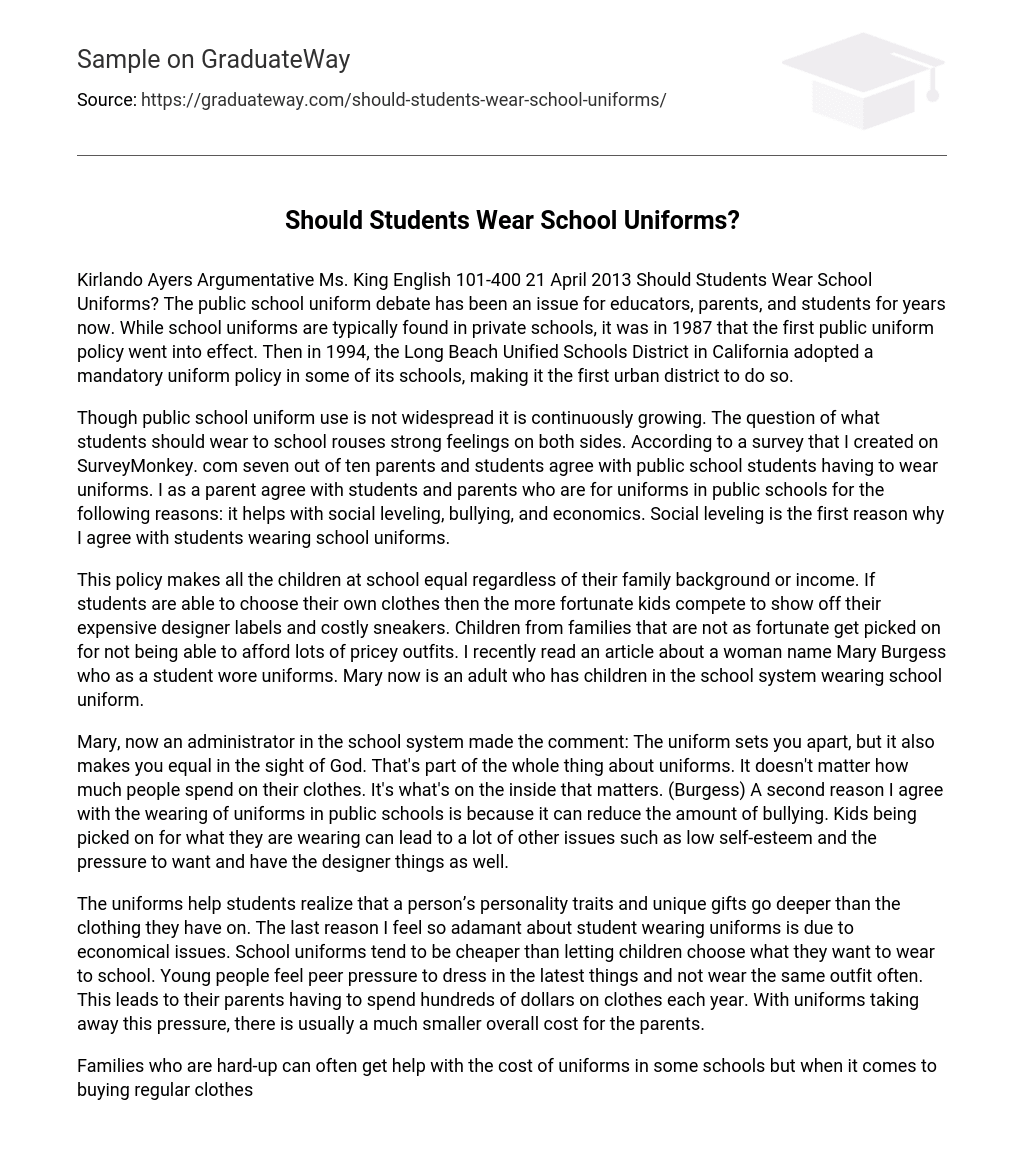The topic of school uniforms in public schools has been a subject of discussion among educators, parents, and students for a long time. While private schools are commonly linked with uniforms, public schools started enforcing uniform policies as early as 1987. In 1994, the Long Beach Unified Schools District in California became the initial urban district to mandate uniforms at specific schools.
While the use of public school uniforms is not widely implemented, it is steadily growing. The topic of student dress code generates strong opinions from both sides. Based on a SurveyMonkey.com survey I conducted, seventy percent of parents and students are in favor of public school students wearing uniforms. As a parent myself, I agree with those who propose uniforms in public schools due to various reasons: it fosters social equality, decreases bullying incidents, and enhances economic factors. Encouraging social equality is my main motive for endorsing student uniforms.
This policy promotes equality among all school children, regardless of their family background or income. If students are allowed to wear their own clothes, it creates a situation where wealthier children flaunt their expensive designer labels and expensive sneakers, while less fortunate children are targeted for not being able to afford costly outfits. Recently, I came across an article about Mary Burgess, who wore school uniforms as a student. As an adult with children in the school system, Mary continues to support the use of school uniforms.
According to Mary, an administrator in the school system, wearing a uniform distinguishes individuals while also promoting equality in the eyes of God. This is an important aspect of uniforms as it emphasizes that one’s inner qualities are what truly matter, regardless of the amount spent on clothing (Burgess). Another reason to support wearing uniforms in public schools is their potential to decrease bullying. When children are targeted for their attire, it often leads to negative consequences such as diminished self-confidence and the desire to own designer items as well.
Uniforms not only promote the understanding that a person’s character and special talents go beyond their clothing, but they also address economic concerns. Typically, school uniforms prove to be more cost-effective than allowing students to select their own attire for school. Many young individuals experience peer pressure to wear fashionable clothes and avoid repeating outfits. Consequently, parents frequently find themselves spending substantial amounts of money on clothing annually. Nevertheless, by implementing uniforms and eliminating this pressure, parents typically experience significantly reduced expenses.
Families in need often get help with buying uniforms for certain schools, but not for regular clothes. A survey conducted by the National Retail Federation (NRF) in 2010 found that households typically spend $234.51 on jeans, shirts, and other clothing, $109.75 on shoes, and $98.37 on school supplies (www.NRF.org). In contrast, buying uniforms is more cost-effective as solid color polo shirts can be bought for $5-$7 and solid khaki pants for $10-$15.
Opinions on the use of uniforms in public schools differ among students and parents. According to my survey, 30% of both students and parents agree that students should wear uniforms and have similar reasons. However, thorough research including article reading, surveys, as well as conversations with parents and students revealed that school uniforms do not genuinely promote social equality. Students will always find means to ridicule or intimidate others based on clothing, hairstyles, height, or weight.
The parents also indicated that uniforms are a means of punishing children for their individuality and believe that uniforms violate the fundamental right of ‘Freedom of Expression’. They advocate for children’s free thinking and expression to foster their development as thinkers of the future, instead of compliant followers. They argue that uniforms restrict personality development and the process of self-discovery; in order to understand their place in the world, children need to understand how they fit into it. Wearing a school uniform (with its emphasis on conformity) could hinder the creation of a unique identity and self-discovery. Some parents specifically mentioned that uniforms would not provide economic benefits.
The cost of uniforms may differ based on the brand and store, but it is typically similar to regular clothing. Nevertheless, children still need extra clothes for evenings, weekends, and holidays. This might prompt parents to contemplate buying two sets of clothing for their kids during the school year, causing financial strain and unnecessary costs. Alternatively, they could choose versatile clothing that can be worn throughout the year and for different occasions, including activities related to school.
Over the years, discussions about public school uniforms have involved educators, parents, and students. As a parent, I agree with the proponents of uniforms in public schools because they can promote social equality, address bullying concerns, and offer economic advantages. In my opinion, these three arguments would greatly benefit both students and parents. Nevertheless, as long as there is an option to not wear uniforms, the debate will persist.
Work Cites
- Cook, Stephanie. “Do school uniforms stifle expression or protect students?. Christian Science Monitor 08 Aug. 2000: 12. Newspaper Source. Web. 29 Apr. 2013.
- Weston, Alonzo. “School uniforms or not?. ” St. Joseph News-Press (MO) 12 Sept. 2010: Newspaper Source. Web. 29 Apr. 2013.
- Ayers, Kirlando. “Should Public Schools Wear Uniforms. “www. surverymonkey. com. 24 May 2013. May . Print.
- Hacker, Diana, and Nancy Sommers. A Writer’s Reference. Seventh. Boston, New York: Bedford/St. Martin’s, 1999. Print.
- Paine, Charles, and Richard Sheehan-Johnson. Writing Today. Second. New Jersey: Pearson Education Inc. , 2010. Print.





